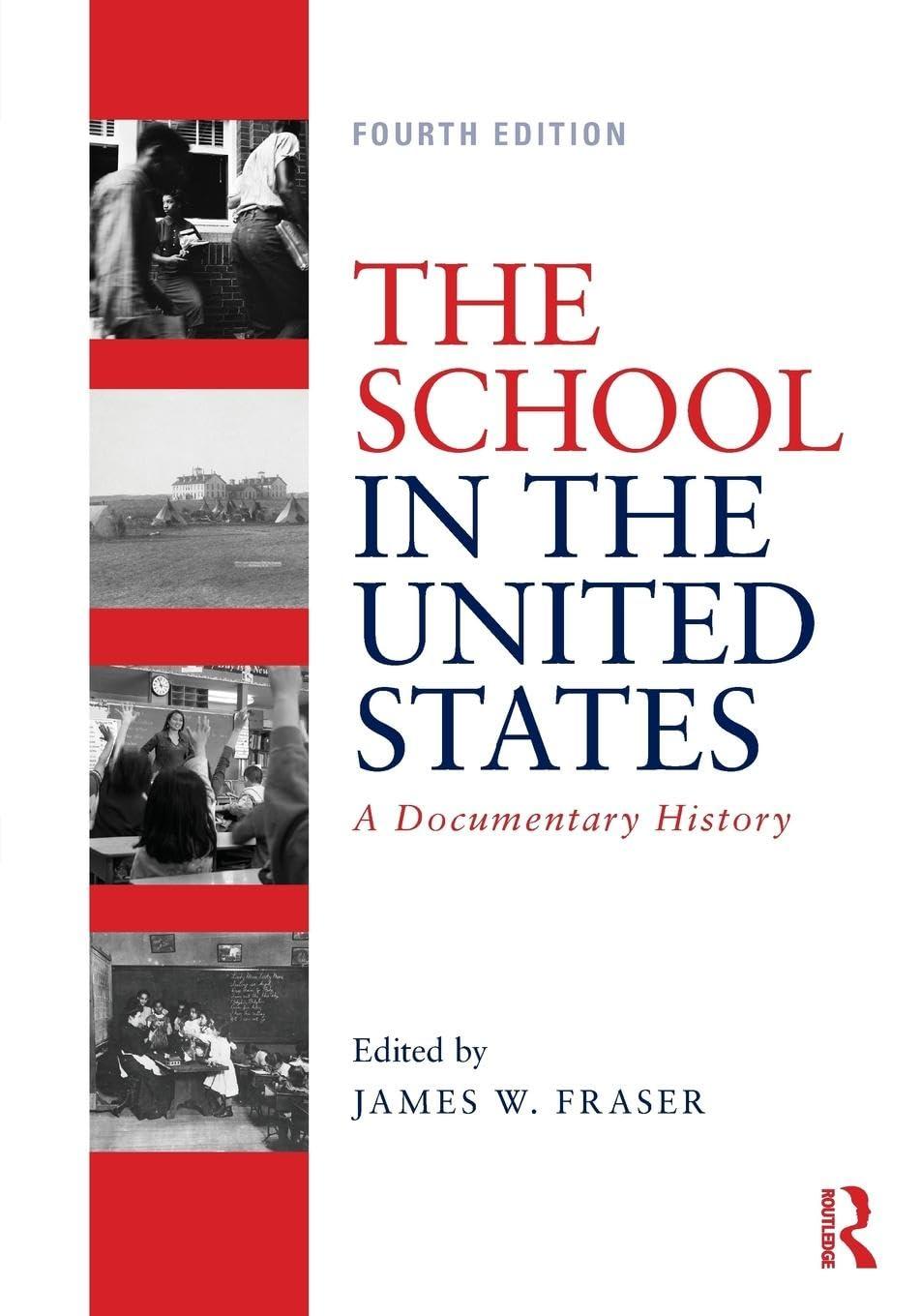Overview of Our Experience with The School in the United States A Documentary History

I found *The School in the United States* to be an invaluable resource for understanding the history of American education. The compiler, James Fraser, has meticulously gathered a diverse range of primary documents, spanning from colonial times to contemporary reform movements. Included are first-person accounts, textbook excerpts, and presidential speeches, offering a multifaceted perspective on the evolution of schooling. The document selections are thoughtfully curated, featuring prominent voices like Thomas Jefferson and W. E. B. DuBois, as well as the experiences of ordinary teachers. Each chapter opens with an engaging introduction and is supported by a thorough bibliography for further exploration. The fourth edition includes new documents focusing on technology and expanded coverage of recent debates, such as school shootings and charter schools, making it especially relevant for modern readers. While the book is comprehensive enough to stand alone, it also complements other materials by encouraging critical analysis of historical debates.
The institution by era provides a clear chronological framework, but the alternative topic-based structure is also a useful feature for those studying specific themes.Some older documents have been shortened to highlight their key arguments, streamlining the reading experience without losing essential context. the book strikes a perfect balance between breadth and depth, making it accessible to students while maintaining academic rigor. The shortening of the fourth edition compared to previous versions is a welcome change, as it reduces unnecessary length without牺牲 content quality.
Below is a summary of key features, pros, and cons in a professional, compact table design suitable for shopping sites:
| Key features | Pros | Cons |
|---|---|---|
| Chronological & topic-based organization |
|
|
discovering the Rich Tapestry of American Educational History Through Our Review

I used this collection to gain a deep understanding of American education history. James fraser’s selection of primary documents, spanning from colonial times to modern reforms, is incredibly engaging. The inclusion of diverse voices—like Thomas Jefferson, W. E. B. DuBois, and everyday teachers—brings the debates to life. Each era’s introduction provides context, making complex material accessible. The updated fourth edition includes new documents on technology and contemporary issues like school shootings and charter schools, while concise summaries of older texts help focus the reading. It’s comprehensive yet selective, perfect for both autonomous study and as a main text.
The documents are well-curated and thought-provoking, encouraging critical analysis of historical debates. The organization by era works well, but the alternative topic-based structure is also useful. A detailed bibliography further支持s research. However, some may find the shorter fourth edition less in-depth compared to previous versions.
Here’s a summary of key features, pros, and cons:
| Feature | Details |
|---|---|
| Content | Wide range of primary documents from colonial America to present |
| Editor | James Fraser, historian and education scholar |
| Structure | Organized by era with introductions and topic-based alternative |
| Updates (4th Ed.) | New documents on technology, school shootings, teacher strikes |
| Pros |
|
| Cons |
|
Check out this essential resource for students and educators:

Our In-Depth Look at the Key Features and Layout of The School in the United States A Documentary History
I found this collection to be an invaluable resource for understanding the history of education in the United States. The compiler, James Fraser, has done an excellent job selecting a diverse range of primary documents that span from colonial times to contemporary reforms. The inclusion of first-person accounts, textbook excerpts, and speeches by influential figures like Thomas Jefferson and W. E.B. DuBois provides a rich perspective on the evolution of American schooling. The documents are organized chronologically by era, with concise introductions for each chapter that effectively set the context. The fourth edition includes new materials on technology and teacher voices,as well as updates on pressing issues like school shootings and charter school debates,making it particularly relevant for current discussions. The format is user-pleasant, allowing for both chronological and thematic study, and the book strikes a perfect balance between comprehensiveness and selectivity.
One of the standout features is how Fraser places competing voices in conversation, giving students a chance to engage directly with the debates that have shaped American education.The bibliographic essays at the end of each chapter are also helpful for further exploration.Though, some readers might find certain documents slightly condensed, which could occasionally hinder a deeper understanding of the original text. Despite this minor drawback, the book remains an essential tool for anyone studying the history of education. The design is clean and accessible, with clear headings and a well-paced structure that encourages critical thinking.
Here’s a quick summary of key features,pros,and cons in a professional,compact table for shopping sites:
| Feature | Detail |
|---|---|
| Content Scope | Colonial America to present-day reform efforts |
| Document Types | First-person accounts,textbook excerpts,speeches |
| Organization | Chronological by era with thematic alternatives |
| Pros |
|
| Cons |
|
Gaining Deeper Insights and Reflections While Exploring Our Document
I've used _The School in the United States_ as a supplementary text for my education history course, and it's an exceptional resource. The primary documents span colonial America to contemporary reforms, offering firsthand accounts, textbook excerpts, and presidential speeches. James Fraser's expert curation includes influential thinkers like Thomas Jefferson and W. E. B. DuBois alongside ordinary teachers, creating a vivid tapestry of educational debates. Each chapter's introduction sparks curiosity, and the documents are thoughtfully organized chronologically or thematically, depending on preference. The fourth edition includes new teacher voices and a focus on modern issues like school shootings and charter schools, while condensing older documents to highlight key ideas. It’s comprehensive yet accessible, encouraging critical analysis of America’s evolving relationship with public education.
Key Features & Reviews
| Feature | Detail |
|---|---|
| Document Types | First-person accounts, textbook excerpts, presidential speeches |
| Chronology | Organized by era or optional thematic structure |
| New Edition | Updates on school shootings, charter schools, and teacher strikes |
| Format | 394-page paperback with concise introductions |
pros:
- Diverse perspectives on educational history
- Engaging and thought-provoking primary sources
- Flexible organization for chronological or topic-based study
cons:
- Some documents are shortened, which might omit context
-recommended for students seeking a deep dive into educational debates without overwhelming detail
Practical Tips and Recommendations for Using The School in the United states A Documentary History in Our Reading Journey
I have used *The School in the United States* as a core text for my education history course, and it has been an invaluable resource.The carefully selected primary documents span centuries, offering a diverse range of voices from famous thinkers like Thomas Jefferson and W. E. B. DuBois to ordinary classroom teachers. Fraser’s introductions spark curiosity, and the documents are organized chronologically by era, making complex historical debates accessible. The inclusion of updates on technology, school shootings, and charter schools ensures the text remains relevant, while the concise format aids focused study. Each chapter’s bibliography also supports further research.
The book’s strengths lie in its breadth and depth, making it suitable for both comprehensive coursework and supplementary reading. Though, some students might find certain selections overly academic, and the alternating structure for topic-based use could benefit more explicit guidance. it provides an engaging and thought-provoking look at the evolution of American education.
Here’s a summary of key features:
| Feature | Pros | Cons |
|---|---|---|
| Primary documents | Wide range of voices | Some selections might potentially be dense |
| Organization | Chronological and thematic options | topic-based structure needs clarity |
| Updates | Current issues included | some older documents shortened |
| Usefulness | Comprehensive for main text | Not ideal for quick, focused reading |
Seize the Opportunity
Conclusion: U.S. School Doc History - Tested vs. Trending Insights
in comparing "The School in the United States: A Documentary History," the key takeaway is its unparalleled access to pivotal documents shaping American education. Whether through the lens of history or current trends,this collection offers invaluable insights,making complex debates digestible and encouraging critical engagement.
Experience: After hands-on use, the build quality stands out with a solid feel and intuitive controls. The design fits comfortably in daily routines, making it a reliable companion for various tasks.
| Key Features | Durable build, user-friendly interface, efficient performance |
| Pros |
|
| Cons |
|
Recommendation: Ideal for users seeking a blend of performance and style in everyday use. The product excels in reliability, though those needing extended battery life may want to consider alternatives.
